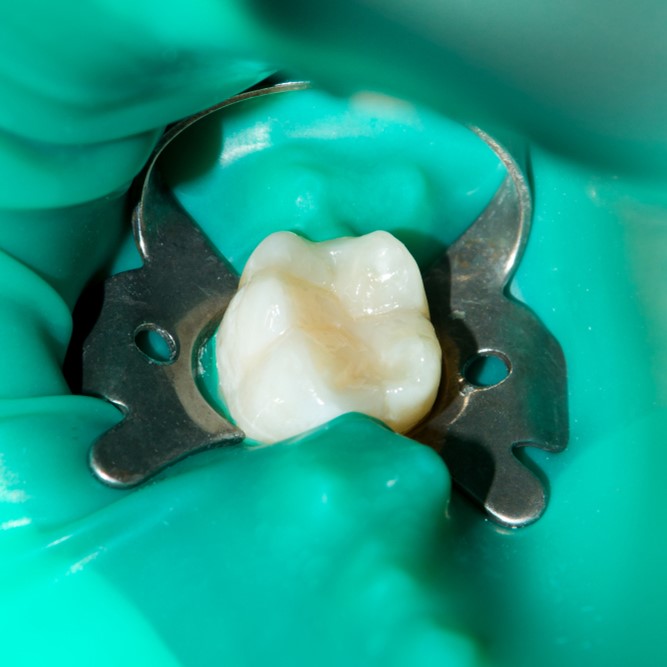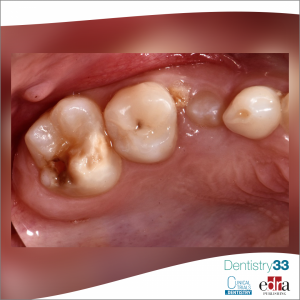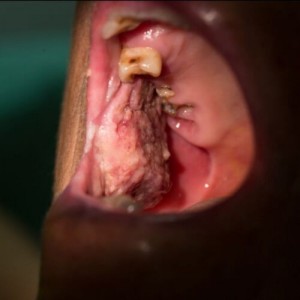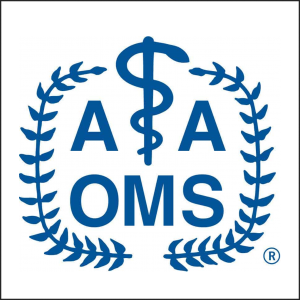
Clinical Management of Molar Incisor Hypomineralization Affected Molars in a Pediatric Patient Including Endodontic Treatment, Case Report and Review of the Literature
he term molar incisor hypomineralization (MIH) describes the clinical manifestation of enamel hypomineralization of systemic origin affecting one or more permanent first molars and incisors. The purpose of this case report is to discuss the management of two mandibular molars with hypomineralization and to emphasize endodontic treatment for pediatric patients. An 8-year-old girl was referred to the pediatric dental clinic for restorations of multiple carious teeth. Upon clinical examination, based on the pattern of enamel hypomineralization and posteruptive breakdown presented, the diagnosis of MIH was established. As a part of the comprehensive treatment, one molar was restored with resin-based composite restorations. The other was endodontically involved and was treated with apexification and then covered with a stainless-steel crown. A two-year recall appointment revealed both molars to be free from signs and symptoms of inflammation. Management of MIH-affected molars should follow a conservative approach and endodontic treatment should be considered.
The term molar incisor hypomineralization (MIH) was first introduced in 2001 referring to the clinical form of enamel hypomineralization of systemic cause affecting one or more permanent first molars (PFMs) and permanent maxillary incisors.Citation1 It can affect from one to all four PFMs. The risk of MIH affecting the permanent maxillary incisors increases with the increased number of PFMs affected. Reports have also indicated that the second primary molars, second permanent molars, and the tips of the permanent canines can be involved.
MIH is a prevalent dental condition that effect up to 25% of children worldwide.Citation3 Its exact etiology remains uncertain. In general, enamel hypomineralization is caused by a disturbance in the function of ameloblast cells during any of the amelogenesis stages. However, it is believed that MIH is due to multifactorial systemic factors that contribute to enamel hypomineralization. Studies show that children born premature or who had poor general health in their early life are at greater risk of developing MIH. Antibiotic use during early life has also been linked to MIH. However, due to the concurrence of disease and antibiotic therapy, it is difficult to determine whether the MIH was caused by the disease or the antibiotic.
Clinical criteria for the diagnosis of MIH were established in 2001, which include: demarcated opacities, posteruption breakdown (PEB), atypical restorations, extraction of molars due to MIH, and failure of eruption of a molar or incisor. Demarcated opacities are enamel defects with altered translucency; the affected enamel is yellow to brown in color and has a clear boundary from normal enamel. The color change reflects differences in enamel hardness, porosity, and mineral content; the darker the color, the lower the hardness and greater the porosity.Citation8 These opacities are usually limited to the incisal or cuspal third of the crown, rarely involving the cervical third.
Surprisingly, the clinically sound enamel in hypomineralized molars is found to have an overall reduction in mineral concentration (of about 5%) and lower calcium/phosphorus ratios, meaning that the entire crown is affected to some extent.
In normal teeth, the surface of intact enamel is typically hard and smooth. Also, the outer surface layer becomes hypermineralized with posteruptive maturation. Instead, MIH-affected enamel is soft and porous and susceptible to posteruptive breakdown (PEB). If not treated, PEB will be complicated by the formation of dental caries, which may lead to pulpal involvement. The purpose of the current case report is to discuss the treatment of MIH-affected teeth in a pediatric patient, with emphasis on the management of two mandibular first molars with hypomineralization defects and posteruptive breakdown. It also highlights the endodontic treatment approach for MIH-affected molars, especially for the immature apexes of pediatric patients.
Author: AbdulAziz A Alsaeed, Jawza H Alfarraj
Source: https://www.tandfonline.com/
 Tag
Tag
 Related articles
Related articles
Endodontics 07 November 2024
Dens invaginatus is a developmental anomaly that poses treatment challenges when nonsurgical root canal therapy is deemed necessary
By Arianna Bianchi
Molar and incisor hypomineralization is a well-recognized enamel quality defect, which can involve one to four permanent first molars, often the permanent incisors.
Dental materials 21 February 2023
Remineralization of molar incisor hypomineralization with a hydroxyapatite toothpaste
Molar incisor hypomineralization is a qualitative enamel defect affecting at least one first permanent molar, with a frequently associated affection of the permanent maxillary incisors or the...
Restorative dentistry 19 January 2022
Co-authors: A. Comba, F. Florenzano
Molar incisor hypomineralisation (MIH) is a developmental dental defect which affect first permanent molars (FPMs) and sometimes permanent incisors. The effects on teeth enamel are presence of...
This clinical study investigated if active caries as assessed by the International Caries Detection and Assessment System were more likely to have positive LC Rinse response than sound surfaces and...
 Read more
Read more
Implantology 17 October 2025
To investigate whether cross-section imaging influences the planning and therapy of standard implant cases in the posterior mandible.
Editorials 17 October 2025
In her new role she is providing direction and supporting initiatives that elevating UFCD's translational research agenda.
Products 17 October 2025
Presto Dental, a new brand affiliated with the Abra Health Group, proudly announces the grand opening of its flagship Connecticut location in Bridgeport. This state-of-the-art.
News 17 October 2025
The American Association of Oral and Maxillofacial Surgeons (AAOMS) celebrated the achievements of more than 30 individuals at the association’s 107th Annual Meeting, Scientific Sessions and...
Phenom, an applied AI company that helps organizations hire faster, develop better, and retain longer, announced The Aspen Group (TAG) earned the Brandon.















